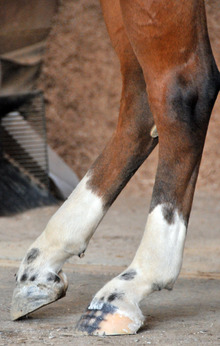Clydesdale horses would benefit from owners knowing more about the likely causes of bog spavin, according to a report published in the Veterinary Record. Bog spavin, the chronic fluid distension of the hock joint, is commonly seen in draught breeds.

Lameness prevention in equines
Bog spavin, the chronic fluid distension of the hock joint, is commonly seen in draught breeds and can lead to osteoarthritis and severe lameness in horses.
© 2012 by April Raine
Martin Weaver and Laura Wilant of the Royal (Dick) School of Veterinary Studies in Edinburgh, Scotland, conducted a survey of Clydesdale owners in both the UK and the USA. They looked at the incidence of the condition and how the owners dealt with it.
Most owners knew of the condition, but were often unaware of its possible significance. Of the 935 horses included in the survey, 10% were reported to show signs of bog spavin.
The owners approach to the condition differed on opposite sides of the Atlantic. In the UK, nearly half of the affected horses were not investigated at all, whereas in the USA over 75% received some investigation – ranging from physical examination by the owner, yard manager or veterinarian, to more specialized techniques.
Radiographic examination was performed on 37.7% of affected horses in the USA , but on just 12.2% in the UK.
Over half of the affected animals first showed signs of bog spavin before they reached one year of age. This is significant as it coincides with the time when osteochondrosis tends to occur.
Osteochondrosis, a disorder of bone development which results in damage to the articular cartilage, is the most common cause of long term joint swelling in young horses showing little or no lameness. If untreated, the condition may eventually result in osteoarthritis and persistent lameness.
Some of the cases of bog spavin identified in the survey could be due to undetected osteochondrosis. The authors suggest that a radiographic survey of Clydesdale horses is warranted to establish the true extent of osteochondrosis of the hock joint.
They argue that if more owners knew about the possible causes of bog spavin they might be more likely to investigate and thus identify those horses with osteochondrosis. Arthroscopic surgery could then be offered to appropriate cases to reduce the risk of osteoarthritis.
Learn more about Bog Spavin
